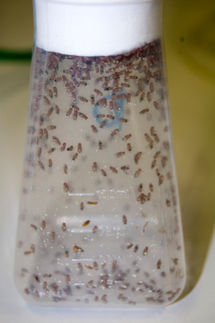Today's white rice is mutation spread by early farmers, researchers say
Advertisement
Some 10,000 years ago white rice evolved from wild red rice and began spreading around the globe. But how did this happen? Researchers at Cornell and elsewhere have determined that 97.9 percent of all white rice is derived from a mutation (a deletion of DNA) in a single gene originating in the Japonica subspecies of rice. Their report, published in PloS genetics, suggests that early farmers favored, bred and spread white rice around the world.
The researchers report that this predominant mutation is also found in the Indica subspecies of white rice. They have found a second independent mutation (a single DNA substitution) in the same gene in several Aus varieties of rice in Bangladesh, accounting for the remaining 2.1 percent of white rice varieties. Neither of these two mutations is found in any wild red rice species. Both mutations produce shortened versions of the same protein in which the missing part is responsible for activating the molecular pathway leading to grain color in rice.
"We think that other domains of this protein are critical for other functions in the plant, because we never see the protein entirely deleted, just the part of the molecule that affects the pathway for grain color," said Susan McCouch, Cornell professor of plant breeding and genetics and the paper's senior author. Megan Sweeney, Cornell Ph.D. '06 and postdoctoral associate, was the paper's lead author.
In 2006 the researchers first identified the gene that makes the rice seed's bran layer, or pericarp, white. This gave rice breeders and engineers a genetic marker to help develop new breeds. The Cornell researchers regularly introduce favorable genes from wild red rices into elite white cultivars to improve yields and provide better responses to stress, but they generally select against the gene for red pericarp because it is associated with such unfavorable "weedy" linked traits as seed dormancy and "shattering" (where seeds fall easily from the stalk).
Organizations
Other news from the department science

Get the life science industry in your inbox
By submitting this form you agree that LUMITOS AG will send you the newsletter(s) selected above by email. Your data will not be passed on to third parties. Your data will be stored and processed in accordance with our data protection regulations. LUMITOS may contact you by email for the purpose of advertising or market and opinion surveys. You can revoke your consent at any time without giving reasons to LUMITOS AG, Ernst-Augustin-Str. 2, 12489 Berlin, Germany or by e-mail at revoke@lumitos.com with effect for the future. In addition, each email contains a link to unsubscribe from the corresponding newsletter.



























































